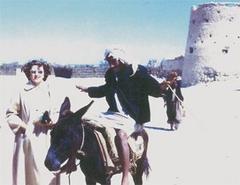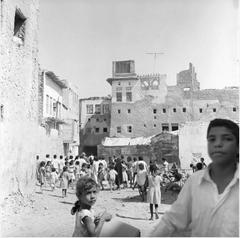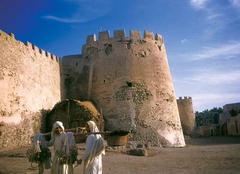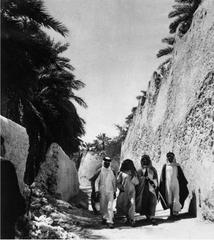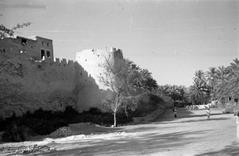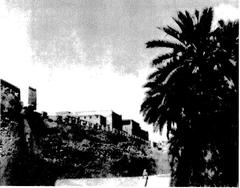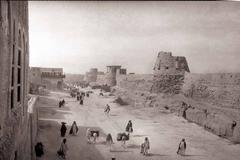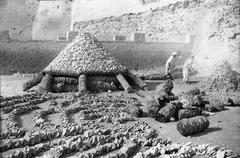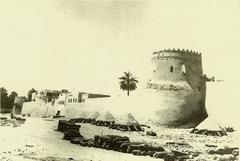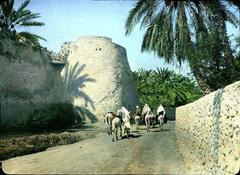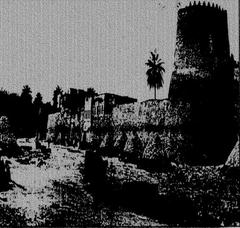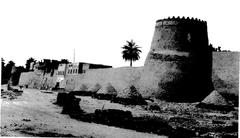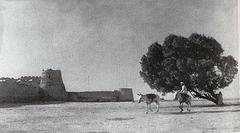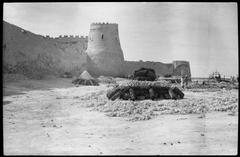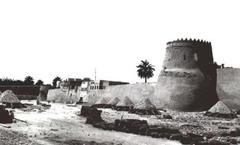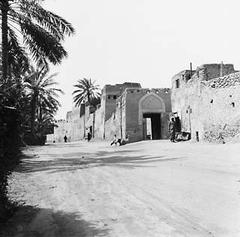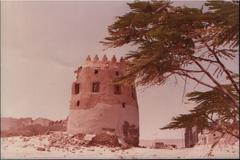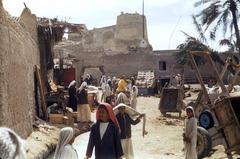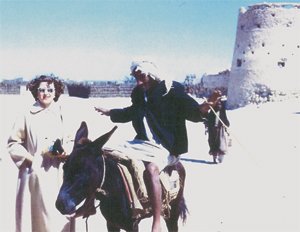
Qatif Castle Visiting Hours, Tickets, and Historical Guide
Date: 14/06/2025
Introduction to Qatif Castle and Its Historical Significance
Qatif Castle, historically known as Qal’at al-Qatif, is one of Saudi Arabia’s most storied landmarks, situated in the Eastern Province. Constructed in the 3rd century CE by the Sassanid Empire, its primary role was as a defensive stronghold safeguarding the oasis city of Qatif—a settlement and commercial hub since 3500 BCE (trek.zone; imamreza.net). Over centuries, Qatif Castle transformed into a vibrant urban center, hosting thousands of residents, bustling souqs, mosques, and administrative buildings, reflecting the area’s complex social and economic fabric (Wikipedia).
The demolition of the castle in the 1980s during urban development marked the end of a physical era, but its legacy endures. Today, visitors explore the original site and the neighboring Qatif Historical District, where traditional architecture and energetic markets echo the castle’s influence (leaders-mena.com; trek.zone). Nearby, Tarout Fort offers further insight into the region’s deep history, with ancient ruins and panoramic views (Welcome Saudi).
This comprehensive guide details Qatif Castle’s origins, architectural features, cultural significance, and practical information for visitors, including visiting hours, ticketing, accessibility, and tips for exploring the historical district. Whether you are a history enthusiast or a casual traveler, this guide aims to deepen your appreciation of one of Saudi Arabia’s enduring heritage sites (Wild Trips).
Origins and Early History
Qatif Castle’s roots trace to the Sassanid era (3rd century CE), when the Persian dynasty established the fortress to control the fertile oasis of Qatif, a city already inhabited since 3500 BCE (trek.zone; imamreza.net; Wikipedia). Its strategic location in the oasis, rich with freshwater springs and fertile land, established the fortress as both a defensive bastion and an administrative center.
Architectural Features and Layout
Though the original structure is gone, records and archaeological studies reveal that Qatif Castle featured robust mudbrick and stone walls, defensive towers, and a central courtyard. The design blended Sassanid military architecture with local Arabian styles, using materials like palm wood and stone (trek.zone). Over time, the castle expanded to include residential quarters, storage facilities, and offices, adapting to the needs of successive rulers (imamreza.net).
Medieval and Early Modern Periods
After the fall of the Sassanids, Islamic dynasties—such as the Abbasids and Buyids—maintained the castle as a regional center. Its importance grew under the Ottomans, who restored and expanded the fortress in the 16th and 17th centuries, reinforcing it to secure their interests and counter Portuguese incursions (imamreza.net; Wikipedia).
Role in Regional Power Struggles
Qatif Castle was pivotal in local and regional conflicts. The Banu Khalid tribe seized it from the Ottomans in the late 17th century. Throughout the 18th and 19th centuries, the castle changed hands among the Ottomans, Banu Khalid, the First and Second Saudi States, and finally the emerging Saudi kingdom in 1913 (Wikipedia).
Social and Economic Functions
Beyond its military and administrative roles, the castle was deeply embedded in Qatif’s daily life. It secured the city’s markets and agricultural lands, supported local elites and officials, and served as a storage site for produce and trade goods (leaders-mena.com; imamreza.net).
Decline and Demolition
With the discovery of oil and the rise of Dammam, Qatif’s significance waned. The castle fell into disrepair and was demolished in the 1980s during urban renewal projects (imamreza.net; Wikipedia). Today, only traces remain, but the site is still a symbol of local heritage.
Visiting Qatif Castle Today
What to Expect
Although the physical castle is gone, the site is open and freely accessible to the public. There are no ticket requirements or official hours, but the best experience is during daylight. The adjacent Qatif Historical District offers a living museum of preserved homes, narrow alleys, and vibrant souqs. Guided tours by local operators and cultural centers provide historical context.
Museums and Exhibits
Artifacts from Qatif Castle are displayed at national museums in Riyadh and local cultural centers. These institutions offer context about the castle’s history and Qatif’s development. Check museum websites or contact local tourism offices for current exhibit information.
Accessibility and Facilities
- Site Accessibility: The district has uneven alleys and surfaces; comfortable footwear is essential. Some areas may be challenging for those with mobility issues.
- Travel: Qatif is easily reached by car or taxi from Dammam or Khobar. Cooler months (October–April) are the most comfortable for exploration.
Visuals and Media
Photographs of the castle ruins, historical district, and artifacts enrich the visitor experience. Use descriptive alt tags like “Qatif Castle ruins” and “Qatif historical district” for better accessibility and SEO.
Frequently Asked Questions (FAQ)
Can I visit Qatif Castle today?
The original castle no longer stands, but the site and the surrounding historical district are open to visitors.
Are there entrance fees or tickets?
There are no entrance fees for the castle site or district. Museum or tour fees may apply.
Are guided tours available?
Yes, local guides and cultural centers offer tours of the historical district and related heritage sites.
Is the site accessible for people with disabilities?
Some areas may be difficult to navigate due to uneven surfaces. The Corniche and modern market areas are more accessible.
Legacy and Cultural Significance
Despite its demolition, Qatif Castle remains integral to local identity. Its memory is preserved in oral histories, art, and annual cultural events (leaders-mena.com; wikipedia). Artifacts and inscriptions from the castle are housed in museums, and the story of Qatif is told through tours, literature, and educational programs (trek.zone).
Modern Commemoration and Visitor Experience
Visitors today engage with Qatif’s history through the historical district, with its narrow alleys, preserved buildings, and lively souqs (trek.zone). Artifacts from the castle are displayed in museums, supporting ongoing research and education (Wikipedia). The site remains a rallying point for heritage conservation efforts (leaders-mena.com).
Visiting Nearby: Tarout Fort
Tarout Fort, on Tarout Island, is another essential historical destination. Built atop the island’s highest hill, it features three preserved towers, panoramic views, and unique construction using gypsum, sea mud, and Fourosh rocks (Welcome Saudi). Visitors can explore the fort from 4:00 PM to 10:00 PM, with free entry. The approach includes a modest climb, and parking is available nearby.
No official guided tours are offered, but self-guided exploration is encouraged. Amenities are limited; cafes and diners on the island provide food and restrooms.
Practical Visitor Information
- Best Time to Visit: October to April for cooler weather.
- Dress Code: Modest attire is recommended.
- Photography: Allowed in most areas; ask permission before photographing people.
- Accessibility: Some historic areas have uneven surfaces and may be challenging for those with mobility impairments.
- Emergency Numbers: Police (999), Ambulance (997), Fire (998).
Recommended Itinerary
- Morning: Explore Qatif Central Market and enjoy a local breakfast.
- Midday: Walk the historic district and visit the castle site.
- Afternoon: Head to Tarout Island and tour Tarout Fort.
- Evening: Relax at Qatif Corniche for sunset views.
Special Events and Festivals
Qatif hosts cultural events, especially in the cooler months, featuring music, crafts, and traditional cuisine. Check with local tourism offices for current schedules.
Summary and Visitor Recommendations
While Qatif Castle’s physical structure does not remain, its legacy permeates the city’s cultural identity and the Eastern Province’s history. Visitors can immerse themselves in the region’s heritage through the historical district, local museums, and the nearby Tarout Fort (imamreza.net; Wikipedia; Welcome Saudi; trek.zone). Plan your trip during the cooler months, use local guides or apps for deeper insights, and explore the markets and festivals for a vibrant cultural experience (Kurby Blog; leaders-mena.com; Wild Trips).
Sources and Further Reading
- Qatif Castle Visiting Hours, Tickets, and Historical Guide to Qatif’s Iconic Landmark, 2025, trek.zone
- Qatif Castle Visiting Hours, Tickets, and Historical Guide to Qatif’s Iconic Landmark, 2025, imamreza.net
- Qatif, 2025, Wikipedia
- Discovering Al Qatif: Hidden Gem in Saudi Arabia’s Eastern Province, 2025, leaders-mena.com
- Qatif Castle: History, Visiting Hours, Tickets & Cultural Significance in Saudi Arabia, 2025, Wikipedia
- Al Qatif: Architectural Evolution, 2025, Injarch
- From Past to Present: The Evolution of Al Qatif, Saudi Arabia’s Architecture, 2025, Kurby Blog
- Tarout Fort Visiting Hours, Tickets, and Exploring Qatif’s Historical Sites, 2025, Welcome Saudi
- Qatif Castle Visiting Hours, Tickets, and Guide to Qatif Historical Sites, 2025, Trek Zone
- Top 10 Attractions to Visit in Qatif, 2025, Wild Trips
- Qatif Travel Guide: Top 10 Must Visit Tourist Places, 2025, Tourist Places Guide
